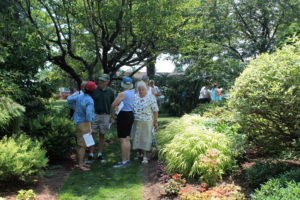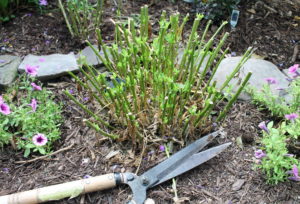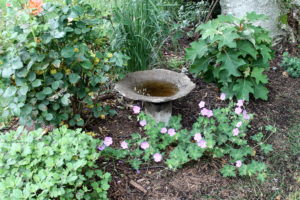Presenting: The Garden
July 17th, 2018
Sue and I had a couple of hundred visitors tour our yard this past Saturday as part of a Penn-Cumberland Garden Club tour.
We didn’t go to a whole lot of extra trouble to make the yard look better than it really is. But we did do a few things ahead of time to help the plants put their best foot forward.
I got to thinking that some of it might be useful to others trying to polish the landscape, whether it’s a tour, a pending sale, or even just having company over.
The most important thing is dealing with weeds. A weedy garden is the house-cleaning equivalent of food smears on the counter, dirt on the carpets, and dust on the tables.
Yanking the weeds does more than anything to show that the gardens are tended.
I went around our yard starting a couple of weeks in advance – bucket and weeding tool in hand – “harvesting” weeds from the beds and lawn. Most went in the compost pile.
I spot-sprayed a few patches of creeping weeds like oxalis and chickweed in the lawn with broadleaf weed-killer (one of the few chemicals I ever use). Creepers are hard to pull and will overtake grass if you don’t stop them early. That at least limits overall herbicide use.
Next up was trimming. I neatened the arborvitae, hollies, boxwoods, and yews, pruned the bloomed-out spring shrubs (spirea, sweetspire, fothergilla, weigela, and deutzia), and cut back perennials that were done blooming and flopping (hardy geraniums, salvia, and catmint).
I also cut back the mums, sedum, and asters that will bloom later and stay more compact if given a late-spring haircut. (Read my past post on “Stake No More” for more on this.)
Then we addressed plants that weren’t looking so good from disease.
Sue’s perennial garden had a couple of clumps of supposedly mildew-resistant phlox that already were 50-percent infected. They were hurting more than helping the look, so Sue clipped them back to stubs. Within days, they were pushing clean, new leaves. Better young and healthy then big and diseased.
I also clipped off a fair number of iris and daylily leaves that were suffering from fungal leaf-streak disease. The clumps ended up smaller and thinner, but the look was a lot better without the brown leaves.
In the lawn, I fertilized in late May to ensure good color and to stimulate growth. The rain we had in May, June, and the week before the tour helped the grass look better than I thought it would coming off of a grub-ravaged last fall. My spring seeding efforts paid off nicely.
Early-summer heat following decent rain also had the vegetable garden looking full and healthy.
I always stay on top of that garden with compost, fertilizer, weeding, watering, and immediately replanting with something new after harvest. My raised-bed system with stone paths helps minimize the efforts.
Sorry, I have no other shortcut advice on keeping a vegetable garden looking good. Regular attention is the answer, lest the whole thing fall apart in a matter of weeks.
I happen to think the results are worth the effort and don’t mind the work at all. I like vegetable gardening and like to keep it chugging along, whether anybody else is going to see it or not.
We did plant a few more annual flowers than usual this year. These add season-long color and give the gardens a full look.
A few weeks before the tour, we bought additional annuals that were on sale for half-price to plug in remaining gaps. Close planting gives more immediate impact. The tradeoff is that things will get crowded later.
I also fertilized all of the pots.
Besides adding annuals, we used a few pots and some of Sue’s artsy creations (hypertufa troughs and leaves, “dish-thing” ornaments, little statues and “found” objects), to fill gaps.
These add fun and personality to the garden while serving as focal-point foils for the plants. A good place for any of these is where two different clusters of plants meet.
I haven’t been mulching all of the beds every spring lately like I used to. To save work, I’ve been mulching every other year and breaking up the job by mulching the front in springtime and the back in fall.
This year, I went back to an 8-yard truck load of mulch (plus another 10 bags or so) to mulch everything at once. Besides helping with weeds and soil-moisture retention, mulch gives a clean, uniform look to the beds.
By tour week, I was down to just a little patrol work.
I cut the grass, weed-whacked the bed edges, and went around deadheading flowers and snipping a few overly long branches.
The yard looked pretty good.
Now if only it would stay that way…










